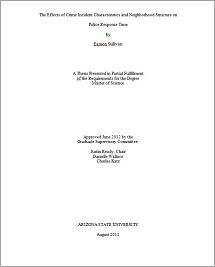The Effects of Crime Incident Characteristics and Neighborhood Structure on Police Response Time
Effectiveness and efficiency of the police have both been contentious topics from the public perspective. Police departments have developed policies to help better their patrol officers' effectiveness on the streets in both quality and timeliness. Although there have been few recent studies about the response time of officers to calls for service, this is a subject that should not go overlooked. As an important aspect to the patrol officer’s repertoire, response time can have effects on the community and their perception on the police. This study uses a multi-level modeling approach to examine the effects of incident and neighborhood factors on police response time within a medium size Southwest Region Police Department, Chandler PD. Police departments use a scale to determine the priority of a call for service, commonly referred to as the PRI. This index scale was found to have the most effect on the response times, while a few cyclical patterns were obtained of level 1 variables. No significant effects were found by any level two variables, measuring structural disadvantage, however, caution should be used in generalizing these findings to other public jurisdictions.
Documents:
|
|
